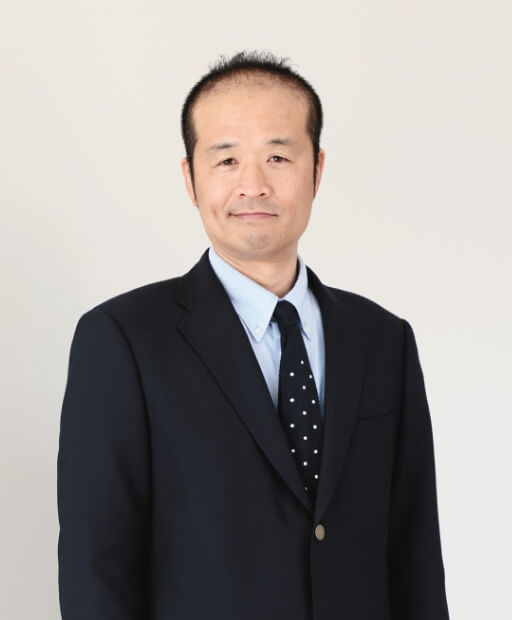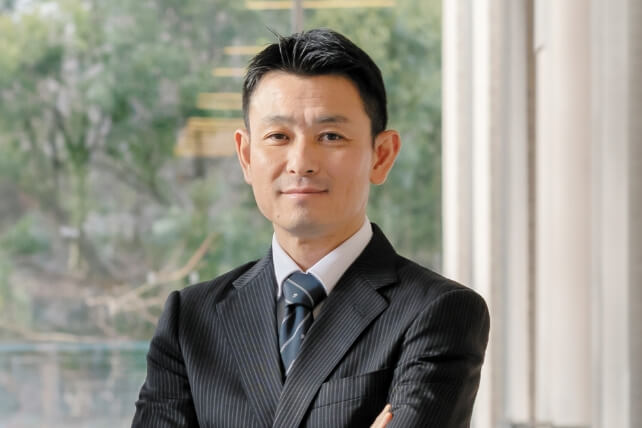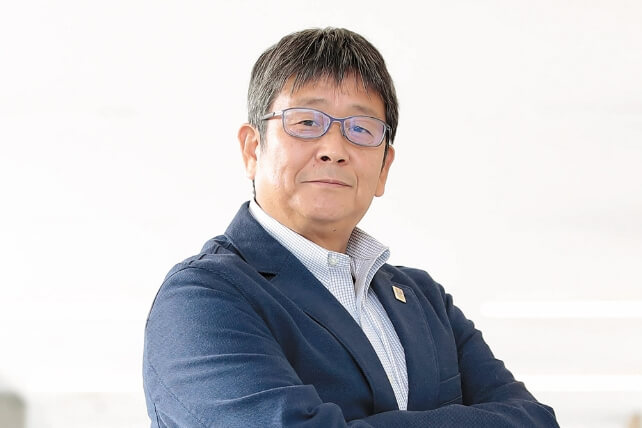Approach to Research
Kenji Ueta
Professor, College of Sport and Health Science
Coordination exercises form the basis of motor skills
- Subject of Research
- Study on relational leadership and organizational environments on motivation
- Research Keywords
- Industrial and Organization Psychology, Social Psychology

Physical play during childhood determines lifelong motor skills
“Simple games played during childhood, such as tag and hide-and-seek, are very important for the development of motor skills,” says Ueta, who works on improving children’s physical fitness and motor skills.
“According to Scammon’s growth curves categorized by different parts of the body, the development of the nervous system which is involved in motor skills, including the brain and spinal cord, is almost complete by early adolescence.” Quality and quantity of exercise performed by this age dictates an individual’s motor skills. Then, what types of exercise are important for the development of the nervous system? Ueta focuses on movement called coordination.
He explained, “Not all our body movements are controlled consciously by mind. Flexible movement with high degrees of freedom can be achieved by joints and muscles working together, controlling motion. Coordination enables these complex connections and cooperation between different body parts.” According to him, coordination can be mainly divided into seven abilities, out of which five abilities i.e. reaction, rhythm, balance, spatial orientation and motor muscle sensory differentiation are important to be enhanced during junior years when the nervous system matures. Physical play during childhood would be an excellent way to develop these abilities.
“There are prerequisites for developing coordination through training. One of them is acquisition of a certain degree of technical skills; for example, juggling bean bags requires basic skills to play, such as holding a bag and throwing it up. Another is not to seek perfection in the performance itself. The main purpose of coordination training is to think about how to do it better through trial and error. If you can do it perfectly, there will be no room to improve. Therefore, training should have many different exercises with a little repetition, or constantly update content by changing conditions frequently to encourage trial and error,” he continued.
Ueta develops coordination training methods and programs for a wide range of people and verifies their effectiveness. He has conducted a study with fifty students in the fifth-grade at an elementary school in Kusatsu, Shiga Prefecture. He devised coordination training exercises, including “marionette,” moving arms and legs like a puppet, “scarf catching,” grabbing a thrown-up scarf, and balance exercise such as standing on one leg with eyes closed and pushing sumo. The students performed these exercises three times a week for five weeks. A motor coordination test was given before and after the training to assess reaction, differentiation and orientation abilities. These abilities improved significantly, confirming the effectiveness of the training.
His recent research has examined how coordination training differs from regular exercise at the cranial nerve level. In an experiment, male and female university students were divided into two groups and one group performed slacklining and the other performed ergometer (bike) exercise for 30 minutes. Slacklining can be classified as a type of coordination exercise that trains balance.
When resting-state brain activity history was assessed using fMRI after each exercise, he found a very interesting phenomenon. Slackline training was significantly associated with the blood flow (information transmission) between the primary motor cortex and the dorsolateral prefrontal cortex, which is linked with cognitive function. These results suggest that balance training could be more beneficial for improving brain function than ergometer exercises.
This study demonstrated the effects of exercise on the brain with objective data, which had been difficult to achieve previously. The data will allow us to create more efficient exercise programs. Interestingly, the study has shown that coordination training may improve cognitive function as well as motor skills. Ueta looks forward to exploring the relationship between coordination training and learning ability in future studies.
Coordination training is emphasized in the development of top athletes. Ueta is taking part in projects to discover and train sport talents in collaboration with Miyazaki and Kyoto Prefectures. He has developed and provided coordination training programs to help identify athletic potential in children. He is also offering a coordination training course to the public at Ritsumeikan University, since it has been reported that coordination exercise is effective for building an injury-resistant body that allows for long-lasting performance during and after adolescence, by which time motor skills have been fully developed. He will continue to explore the potential of coordination through both research and practice.
Coordination Training
An example of coordination training conducted at an elementary schoolMarionette
Level 1
Arms: up and down, 2 beats
Legs: close, close and open, 3 beats
Level 2
Arms: up, side and down, 3 beats
Legs: close and open, 2 beats
Level 3
Arms: right side, left side, right front, left front, 4 beats
Legs: close and open, 2 beats
Balance exercise
Level 1
Standing on one leg with eyes closed
Stand on one leg for 30 seconds with eyes closed, then switch sides.
Level 2
Pushing sumo
Face each other in pairs. At a signal, each attempts to unbalance the opponent using only hands without moving their feet. The one who moves their feet first is the loser. Then repeat this with one leg raised.
Level 3
Jumping over and passing under
One member of a pair gets down on all fours. At a signal, the other person passes under the partner on all fours, and then jumps over the partner who has changed to a prone position. Repeat this. Count how many times they can jump over in 20 seconds.
Balance exercise
Level 1
Throw up catch single
One member of a pair throws a scarf directly above them, touches a hand of the partner facing them, and then immediately catches the scarf before it hits the ground.
Level 2
Throw up catch pair
Partners simultaneously throw a scarf directly above them at a signal, immediately move to catch the partner's scarf and catch it before it hits the ground.
Level 3
Specified color catch
One member of a pair holds three different colored scarves, throws them up directly above them at a signal and names two colors at the same time. The partner turns around and catches the named scarves before they hit the ground.
Other Researches

Professor, College of Sport and Health Science
Approaching the mechanism of exercise effect

Professor, College of Sport and Health Science
Preventing sarcopenia which leads to lower QOL

Professor, College of Sport and Health Science
Relationships of trust making for a stronger team
